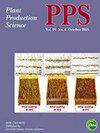四种谷子的耐缺氧性与不定根的组成通气组织形成和根毛发育有关
IF 1.3
3区 农林科学
Q2 AGRONOMY
引用次数: 2
摘要
摘要以谷子不定根的氧获取机制为研究对象,探讨谷子的耐缺氧机制。选用鼠臂藻、水蛭、漆包草和狗尾草。30天大的植株水培28天作为对照,继续曝气并进行低氧处理,其中冲氮以降低氧浓度。从基于植物生长速率的胁迫敏感性指数来看,毛茛和毛茛的耐缺氧性高于白刺和意大利白刺。高耐氧品种的根生长速率、叶片和茎部氮浓度以及单株钠浓度均不随缺氧处理而变化。低氧敏感种谷子根系生长速率降低,叶片和茎中氮浓度降低,全株钠浓度升高。耐缺氧谷子不定根的柱面积占比小于易缺氧谷子,溶解性通气组织组成发育。此外,在耐缺氧的谷子品种中,在根尖附近观察到根毛。综上所述,我们推断谷子的耐缺氧能力主要是通过沿不定根的溶生性通气组织向根尖供应氧气。较低的耗氧量和较小比例的骨面积可能是一个重要的遗传性状。此外,根毛可能有助于营养吸收。图形抽象本文章由计算机程序翻译,如有差异,请以英文原文为准。
Hypoxia tolerance of four millet species is attributable to constitutive aerenchyma formation and root hair development of adventitious roots
ABSTRACT The purpose was to elucidate the hypoxia tolerance mechanism of millet species by focusing on the oxygen acquisition mechanism of adventitious roots. Brachiaria ramosa, Echinochloa utilis, Eragrostis tef, and Setaria italica were used. Thirty-day old plants were hydroponically cultivated for 28 days as the control, where aeration was continued and a hypoxia treatment was applied, where nitrogen gas was flushed to reduce the oxygen concentration. From the stress susceptibility index based on plant growth rate, it was clarified that E. utilis and E. tef had higher hypoxia tolerance than B. ramosa and S. italica. Root growth rate, nitrogen concentration of leaves and stems, and sodium concentration per plant of the higher hypoxia-tolerant species did not change with hypoxia treatment. In hypoxia-susceptible millet species, the root growth rate and nitrogen concentration in the leaf and stem decreased, and the sodium concentration in the whole plant increased. The proportion of the stele area of the adventitious root of the hypoxia-tolerant millet species was smaller than that of the hypoxia-susceptible millet species, and the lysigenous aerenchyma was constitutively developed. Furthermore, root hairs were observed near the root tip in the hypoxia-tolerant millet species. In conclusion, we deduced that the hypoxia tolerance of the millet species is mainly attributable to the supply of oxygen to the root tip via the lysigenous aerenchyma along the adventitious root. Lower oxygen consumption by a smaller proportion of the stele area might be an important genetic trait. Furthermore, root hair may contribute to nutrient absorption. Graphical Abstract
求助全文
通过发布文献求助,成功后即可免费获取论文全文。
去求助
来源期刊

Plant Production Science
农林科学-农艺学
CiteScore
5.10
自引率
4.00%
发文量
27
审稿时长
>36 weeks
期刊介绍:
Plant Production Science publishes original research reports on field crops and resource plants, their production and related subjects, covering a wide range of sciences; physiology, biotechnology, morphology, ecology, cropping system, production technology and post harvest management. Studies on plant production with special attention to resource management and the environment are also welcome. Field surveys on cropping or farming system are also accepted. Articles with a background in other research areas such as soil science, meteorology, biometry, product process and plant protection will be accepted as long as they are significantly related to plant production.
 求助内容:
求助内容: 应助结果提醒方式:
应助结果提醒方式:


